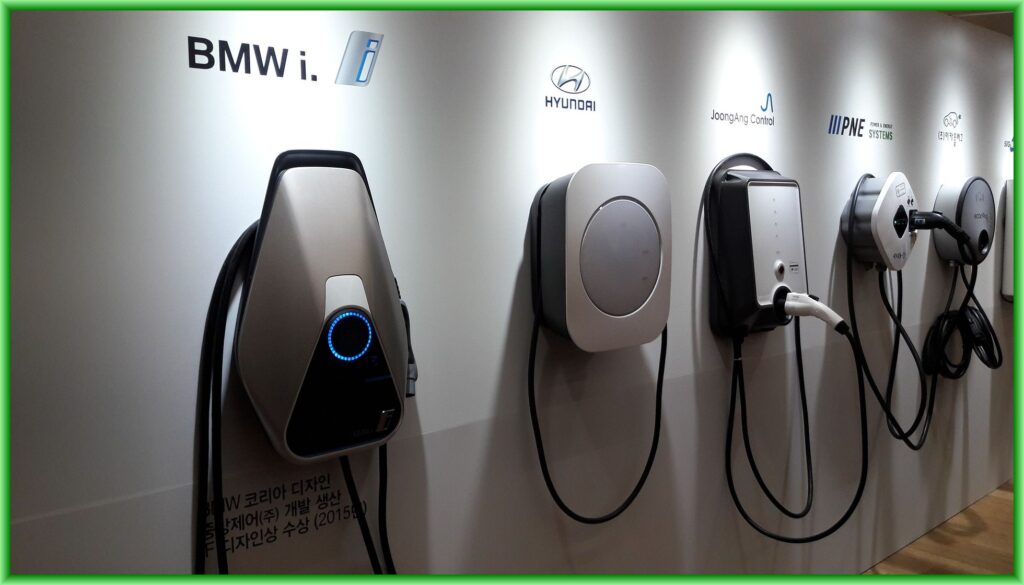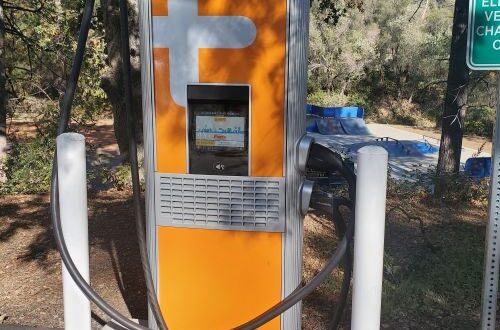Architects and EV Chargers

The 2022 California Green Building Standards Code has a new learning curve for architect’s and EV chargers. This is no longer an issue they can simply delegate to the contractor or electrical the engineer.
If your project is a multi-family, or hotel or motel, the impacts will run into the hundreds of thousands of dollars.
There is no doubt that the California Energy Commission, via the CalGreen Code, has made a logarithmic jump into mandatory electric vehicle charger requirements. This is not about adding more rough-ins for future.
As a minimum, sixteen to twenty-five percent of the parking spaces have to have EV chargers or receptacles installed and functional.
The secondary impact is the massive new electrical load this places on the project. To put this in perspective, for a project we recently worked on, the EV charger requirement doubled the electrical service size to the site! This more than doubled the PGE service costs, the conduit and wire costs, and increased the electrical room size requirements.
Yet, as serious as the above issue are, they are not the worst problem for the project. The worst problem for the project is the lifetime of energy bills for the owner.
We have addressed the infrastructure issues in two previous articles. One is the 2022 CalGreen Code EV Charging Requirements. The other is the 2022 CalGreen Tier 1 and 2 EV Requirements. These articles explain some of the design and construction issues related to the new requirements.
This article, however, will explain how architects and EV chargers can present a positive benefit to the building owner. In fact, they can create a new revenue stream that will provide a positive income for the life of the facility.
The one caveat is that the planning for this needs to begin early in the design phase of the project.
This article will explain the how, why, and when architects and EV chargers can turn this new code requirement into a cash cow for the owner.

The Owner’s Cash Cow
“Dear Mr., Miss, Mrs., and They Architect:
I understand you are overloaded on the never-ending learning curve required by the changing world of architecture. The last thing you want is to try and stuff into your over-flowing brain anything to do with electrical chargers. They have near zero to do with the design of your building. It’s an electrical engineer problem, right? I am truly sorry to say, not anymore. Unfortunately, the damn California Energy Commission has now made it your problem. However, if you just bare with me for a few more paragraphs I will show you how you can pass of the majority of this effort to someone else, while making the owner feel like you are the hero of the story.”
Let’s start at the end where you become the hero/heroine/they-roine of the story. You do this by getting just a little knowledge on the subject. Then you explain to the owner how EV chargers are going to provide a profitable income for the life of the building.
However, your first question is likely, “Why can’t my electrical engineer just take care of this?”

Why Can’t the Electrical Engineer Take Care of This?
The short answer is they can. In fact, we were recently contacted by an owner whose design team had done just that. The project was a large new church.
The project electrical engineer had read the CalGreen Code and followed it precisely. Everyone went on their merry way, the project got permitted, and it went to bid.
Apparently, no one on the design team thought to consider the capitol and long term owner cost for the one hundred electrical vehicle chargers that had been put into the electrical design.
The CalGreen Code requires a 40 amp, 240 volt circuit for each charger. The electric vehicle chargers, alone, require a 4000 amp service!
To put this in real-world terms, this would be in the range of the total power required for a new 100,000 square foot office building. The over-all capitol cost will likely exceed half a million dollars, just to install the power service for the church’s EV chargers.
Yet, the capitol cost is just a drop in the proverbial bucket compared to the potential operational costs. The engineer, made the low cost decision to install simple EV charging receptacles, and not “manageable” charge stations. This made designing the system simple, and provided the lowest installed cost. However, the church was left with no way of passing the energy use costs onto the parishioners.
With just a little forethought and planning the, the electrical service size, and the overall capitol costs, could have been drastically reduced.
Further, with a little bit of planning and owner coordination, the installation could have assured a reasonable payback on the investment. After the payback period, the church could have a received lifetime “tithe” courtesy of their knowledgeable architect.
I suspect that after a few months, ninety percent of these chargers at this church will mysteriously become “out of service”. The EV charger energy costs may exceed the tithes of their congregation.
This is an actual project, and not something I’ve made up for the purposes of this article. I can guarantee there are projects in design right now that are going to end up in the same sad and costly scenario.
A responsible architect should take charge of this issue early in the project and not simply delegate this issue to the electrical engineer. A little knowledge can turn this into a positive benefit to the owner.
Where to Start?
The first step for architects and EV chargers is to understand the magnitude of the issue for your project. Table 5.106.5.3.1 of the California Green Building Standards Code (ie: the “CalGreen Code”) sets the required number of EV charge stations based on the total number of parking spaces for the facility. In rough terms the EV chargers required range from 16% to 25% of the total parking spaces.

EV Charger Requirements
The detailed requirements are outlined in the CalGreen Code section 5.106.5.3.. Unfortunately, the terminology used is not intuitive and can lead to misunderstandings of the requirements. The two articles referenced above provide a detailed explanation of these terms as well as providing examples of sample projects for clarification.
Some of the options to consider include the type of chargers to be provided. If the project requires four chargers or less, 40 amp/240 volt receptacles will be the least capitol cost. However, the owner may end up paying all of the electrical use charges.
For larger projects there are a variety of options. These range from using multi-outlet charge stations, selection of slow and fast chargers, charger locations, as well as owner installed versus charger company turnkey installation.
Capitol costs can be included in the owner’s budget where they can reap the full income from the chargers. Alternatively, a charge company can be engaged to provide the full installation and operational control while keeping all of the charger income.
There are financing options that fall in between these two extremes which may be to the owner’s benefit.
If your project has 25 parking spaces or less, the impact may be somewhat minimal as only four EV charge stations will be required.
If your project has 51, or more, parking spaces then a careful analysis of the requirements and options should be seriously considered.
Another consideration is whether to install some fast chargers, instead of just Level 2 standard chargers. This is an option and not a requirement, but fast chargers can allow the owner to charge higher usage rates and generate more income. Of course the capitol costs are a bit higher but this may pay off in the long run. Fast chargers are referred to as Direct Current Fast Charging (DCFC) in the CalGreen Code.
As the architect of record it is important that you have a basic understanding of the EV charging requirements and options for your project. This is due to the significant capitol costs, as well as the long term operational issues for the owner.
If you are still unclear, we can provide a business case analysis for your project. We will detail the quantity and type of chargers to be considered. We will provide guidance on the various charger configurations and layout considerations. We will outline the various contractual options provided by the leading EV charger suppliers. We can also act as a resource when presenting these options to the owner.
CalGreen Energy Services Inc. is an independent consultant that is not, in any way, affiliated with any EV charger company. As such, we can provide a fair comparison of the various companies and charger options.
Which Charger Companies Should I Consider?
As with any equipment provider on a project there are some basic issues which must be a priority. These include a system compatible with the needs of the owner, availability of local service and maintenance, equipment reliability, economics, long term stability, and ready support.
In addition, there may need to be a long term service contract, monthly reporting on energy usage, reimbursements of income, maintenance and security issues, software upgrades, tax reporting, and data collection reports.
The EV charge system will require the owner to manage the system to one degree or another. It is important to work with the owner to establish a clear understanding of these, and other issues.
While the above issues may sound a little over-whelming, the larger EV charger companies have developed standard procedures to minimize the workload of the owner.
In California the leading suppliers of commercial EV chargers include ABB, Blink, EVgo, and Chargepoint. We are familiar with these companies and their offerings and address the pros and cons in our EV charger business analysis. 
Show Me the Money!
When an electric car plugs into a charge station, the chargers software system records the energy usage, the current utility providers energy cost, and bills the user for the service. The rates the system charges for the power is set by the system owner.
So, if the current PGE or SoCal Edison rate is 25 cents per kilowatt hour, the system may charge say 35 cents per kilowatt hour. The difference provides the income to the owner. The owner decides how much to charge the users and hence how much income they will reap from the system.
The owner can change the user rates at any time, or even set up different rates for time of day or special events. Or they can lock out the systems on weekends if they don’t want non-employees using the equipment during non-working hours.
For information on what charge companies are charging check out Plugshare.com.
It is important to understand that data collection is a very important aspect of the charger system. This data can be used, over time, to maximize both usage and income. In some cases the collected data can be sold to information collection agencies. In addition, charger LED screens can provide advertising for other companies to sell their products and services.
Large number of EV chargers that are used regularly can provide a significant income for a knowledgeable owner.
What Do I Need to Show On the Permit Plans?
EV chargers will have an impact on the electrical service to the site. For this reason, it is important that this load be included in the electrical load analysis for the project in order to determine the required transformer and service capacity.
In addition panel space, wire, conduit size and routing, and charger type and quantities need to be shown on the permit plans. Also, internet interface components will need to be shown which may include an on-site, or offsite, computer for monitoring the charger systems.
Larger systems will require input and coordination with the EV charger supplier. This will be necessary to ensure the system design is in accordance with the contractual arrangement that the owner has made with the supplier.
Can the permit plans be non-charger specific? We recommend that an owner choose a charger company early in the project and work exclusively with them. The reason is that this is a relatively new industry without many recognized standards. As such, each vendor has different product offerings, different hardware and software, and different ways their chargers function.
Attempting to design a generic EV charger system in the hope of getting competitive prices is likely to have any number of unintended consequences. These could include a bid challenge, or a costly change order for the company selected by the general contractor.
Summary
I hope the above information succeeds in stressing the importance for architects and design professionals to take a proactive role in the planning and owner coordination of EV chargers.
Once you have the basic understanding of the issues, the actual time investment is quite small. When you’ve been through the process a couple of times the small time investment can pay large dividends with owner satisfaction. After all, how many jobs have you ever done that ended up providing an additional revenue stream for a client as a direct result of your guidance?
Those who have worked with me, or have read information on my website, know that I am always happy to share my knowledge on the CalGreen Code. However, the EV charging requirements have created such a flood of information requests, that it is negatively affecting my business. I can no longer accept inquiries on the EV charging requirements of the CalGreen Code. Nor do I wish to act as a consultant on this subject.
If you have questions on this code I suggest you try calling the California Energy Commission, Building Energy Efficiency Standards, at 800-772-3300. Or you can email them at title24@energy.ca.gov.


Gary Welch has over 35 years experience in the field of sustainable building design. He is the CEO of CalGreen Energy Services. Gary is an ICC Certified CalGreen Special Inspector and Plans Examiner.

